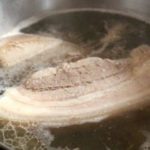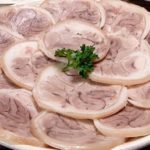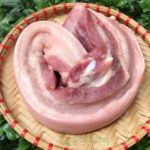How to Remove Pork Odor
Typically, healthy pigs that are raised in “clean” conditions will have fragrant and delicious meat. However, the current market is flooded with pigs that have been fed with growth hormones, resulting in pork meat that often has an unpleasant odor.
If you purchase meat with an odor, you should first clean it and follow these tips to remove the odor:
– Before boiling, remove any dirt, chemicals, or odors by rinsing several times with clean water. Additionally, you can dissolve a small amount of salt in water and rinse the meat with it, as diluted salt water also helps remove impurities.
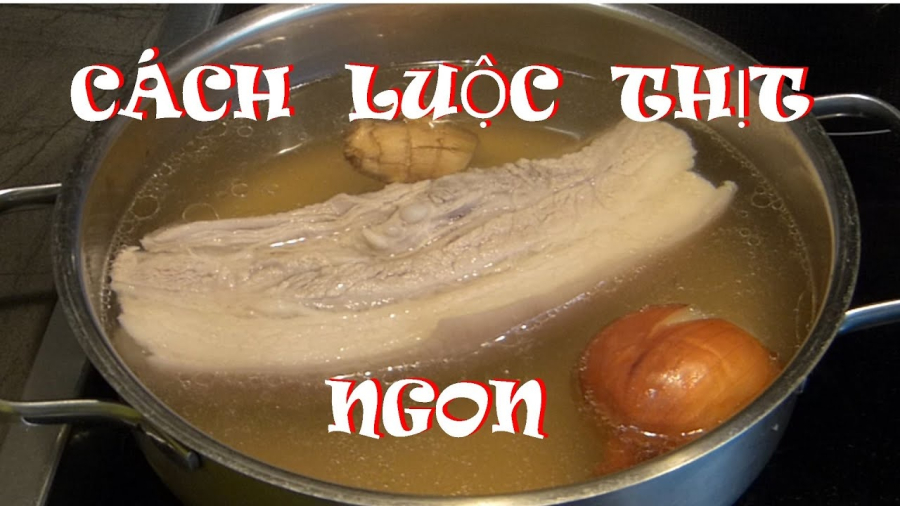
The secret to delicious and odorless boiled pork is to boil it twice. The first time is a quick boil, while the second is to boil it until fully cooked.
Prepare Ingredients
Pork: 0.5 kg (you can use pork belly, rump, shoulder, etc., but choose a cut with both lean and fatty meat so that it won’t be dry and will look appetizing)
1 onion
1 bulb of garlic
A few slices of ginger
Spices: salt
To ensure that the boiled pork is white, appealing, and not dry, you’ll need: white vinegar or lemon juice
To make delicious and white boiled pork, follow these steps:
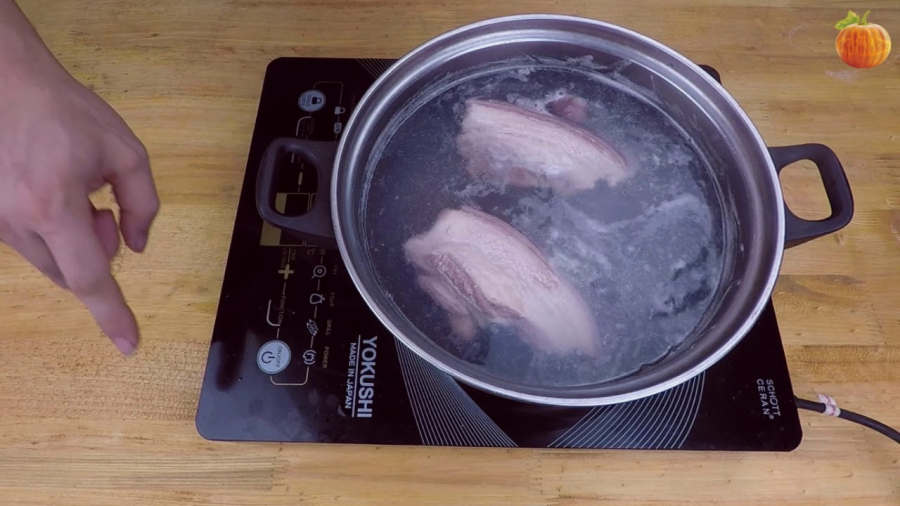
Boil pork deliciously
Step 1: Clean the Pork
After purchasing the pork, remove any remaining hair on the skin with a sharp knife. Rub salt all over the meat or wash it with diluted salt water. Rinse with clean water.
If the meat is thick and large, you can divide it into portions so that it cooks evenly and faster.
Avoid cutting the fresh meat into too small pieces before boiling, as it will shrink and become dry.
Step 2: Remove Odor from the Pork
For delicious boiled pork, the first step is to remove any unpleasant odors. A tip for boiling pork is to boil it twice. The meat should be blanched once before boiling.
Add spring onions, garlic, and smashed ginger to a pot of water. This will help flavor the pork and eliminate odors.
Place the meat in the pot with cold water. This will help release any impurities (Remember: skim off any foam during the boiling process). Blanch the meat for 2-3 minutes before removing.
Step 3: Boil the Pork
Put the blanched pork in a pot and fill with cold water until the meat is submerged. Add the smashed onion (1 bulb) and spring onions, along with a few slices of ginger. You can also add some salt for extra flavor if desired.
The average boiling time for pork is 20-25 minutes; this will ensure that it is cooked and delicious without being dry or tough. However, you may need to adjust the time depending on the thickness of the meat.

When boiling the meat, keep the heat at a low/medium setting to allow for even cooking and tender meat. Bring to a boil and then reduce heat.
Common Mistakes that Result in Subpar Boiled Pork
- Overcooking: Many people overcook pork out of fear that it will not be cooked through. Overcooking causes the lean parts of the meat to become dry, and cooking it for even longer will result in the entire piece of meat becoming mushy, soft, and flavorless. Overcooking pork can also affect its nutritional value. According to experts, between 200-300 degrees Celsius, amino acids, creatinine, sugar, and other harmless compounds in meat react chemically to form harmful compounds. Therefore, when boiling pork, only boil it until it is cooked through. This will ensure that it remains flavorful, aromatic, and tender.
- Adding Cold Water: Adding cold water to a boiling pot is a common mistake when boiling pork, especially when the water level starts to drop. The sudden temperature change causes proteins and fats to coagulate immediately, and the grooves and openings in the meat will contract, making it difficult to tenderize. The lean parts will become tougher, and the fresh flavor of the meat will be compromised. Therefore, you should fill the pot with enough water to cover the meat. If you need to add more water, use boiling water. If you notice that the water is evaporating, add boiling water.
- Constant Poking: Out of impatience or fear of not being able to control the doneness of the meat, many people repeatedly poke and flip the meat while it is boiling. This causes the meat’s natural juices to escape, resulting in a loss of flavor and a drier texture.
- Immediately Cutting the Meat After Boiling: To preserve the heat, many people cut the meat as soon as it is boiled. This is a mistake because the meat will be difficult to cut into neat, “sharp” slices while it is still soft and tender. It is best to place the meat in a bowl of cold water for about a minute before slicing. The meat will remain warm and delicious while looking visually appealing.
- 0.5 kg of pork (belly, rump, or shoulder cut with both lean and fatty meat)
- 1 onion
- 1 bulb of garlic
- A few slices of ginger
- Salt to taste
- White vinegar or lemon juice (to ensure the pork is white and appealing)
- Clean the pork by removing any remaining hair on the skin and rubbing salt all over the meat or washing it with diluted salt water. Rinse with clean water.
- Remove odors from the pork by blanching it in a pot of water with spring onions, garlic, and smashed ginger. Place the meat in cold water, bring it to a boil, and blanch for 2-3 minutes.
- Boil the pork again in a pot with cold water, adding the smashed onion, spring onions, ginger, and salt to taste. Boil for 20-25 minutes or until fully cooked, depending on the thickness of the meat.
- Overcooking: Avoid boiling pork for too long, as it will make the lean parts dry and the entire piece mushy and flavorless. Boil only until it is cooked through.
- Adding Cold Water: Do not add cold water to a pot of boiling pork, as it causes proteins and fats to coagulate immediately, making the meat tough and compromising its flavor.
- Constant Poking: Refrain from repeatedly poking and flipping the meat while boiling, as it causes the natural juices to escape, resulting in a drier texture and loss of flavor.
- Immediate Cutting: Do not cut the meat immediately after boiling. Instead, place it in a bowl of cold water for about a minute before slicing to ensure neat, sharp slices.


























